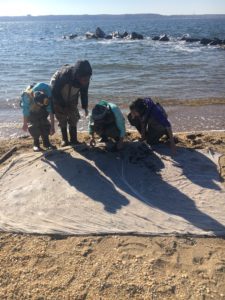Sea Grant Programs Highlight K To Gray Education During 50th Anniversary
The National Sea Grant College Program has spent the last year recognizing its 50th anniversary. Each month, Sea Grant programs across the country have worked together to create content to highlight Sea Grant successes with a monthly theme.
January’s theme was “K To Gray” education. New Jersey Sea Grant Consortium’s education program holds a wide variety of programs directed towards advancing greater understanding and stewardship of our state’s marine and coastal resources. Collectively, these programs engage a large and diverse audience of learners. Our K-12 field trip program alone provides instruction to over 20,000 school children annually, taking them out of the classroom and onto the beaches, bays, and estuaries of New Jersey for active learning experiences.
To highlight these programs, the Consortium contributed an article on everything from summer camp to underwater exploration to be featured on the National Sea Grant homepage. The Consortium is also featured in an interactive story map covering education programs across Sea Grant’s entire network of coastal and Great Lakes states.
Check out the story map and read the article below to see how Sea Grant educators work in New Jersey and across the 33 other Sea Grant programs.
New Jersey Sea Grant provides ideal space for outdoor learning
There’s a special kind of energy that runs through New Jersey Sea Grant Consortium’s headquarters when students are present. Their excited voices, ready to learn, ring through the halls of the NJSGC in historic Fort Hancock, N.J.
Claire Antonucci, executive director of New Jersey Sea Grant Consortium loves that her office is so close to the classroom, the terrapin tanks and the action of education.
Students look out to the New York City skyline which can be seen from Sandy Hook. Credit Rebecca Nagy
“The enthusiasm I hear in their voices is downright inspiring,” notes Antonucci.
Each year more than 20,000 students make their way to the Consortium to learn more about the science of the Jersey Shore. Field trips cover topics from barrier beach dynamics to salt marsh ecology while summer camp may focus on oceanography or using robotics in ocean exploration.

Students learn both in the classroom and out in the field. The classroom is equipped with aquaria filled with native species, college-level microscopes donated by Middlesex County College, sand samples from all over the world, beakers, test tubes and more. But just outside lies is the real treasure — Gateway National Park: Sandy Hook.
Situated on a peninsula — with Sandy Hook Bay on one side and the Atlantic Ocean on the other — the Consortium is perfectly located to facilitate a wide variety of programs directed towards advancing greater understanding and stewardship of our state’s marine and coastal resources.
“I always tell people we have the best outdoor classroom. In a small area we can explore estuarine environments, barrier beaches and a maritime forest,” notes Diana Burich, K-12 program coordinator and Sea Grant program associate. “We’re just steps away from well-established dunes and the largest holly forest on the east coast,” she continues.
Students from Keane University’s campus exchange program in China seine in Sandy Hook Bay. Credit: NJ Sea Grant
Carleigh Engstrom, now a teacher at Biotechnology High School in N.J. worked as a field guide at the Consortium for three years as an undergraduate student at Monmouth University. As a secondary education major she already had experience with high school-aged students, but her experience as a field guide allowed her to broaden her teaching horizons.
“Taking learning out of the classroom allows for students to gain a fresh perspective and have fun, while getting an in depth understanding of Fort Hancock history, biodiversity, beach dynamics and salt marsh ecology,” Engstrom says.
In addition to younger explorers, college students come to take advantage of the learning opportunities at Sandy Hook where college-level classes are held in cooperation with NJSGC participating member institutions from across the state.
The Consortium also attracts scouts from the Tri-State region. NJSGC’s ever-growing scout program currently offers 14 Girl Scout and 11 Boy Scout programs. In the fall of 2015 alone, programs were offered for 35 different troops and several hundred individual scouts working towards the Boy Scout Oceanography and Environmental Science Merit Badges.
Students utilize college-level microscopes to study microscopic organisms in water. Credit: NJ Sea Grant
While there are many long-established education programs at the Consortium, the NJSGC staff is always looking for new and exciting opportunities to educate students on marine science. In the summer of 2016, New Jersey Sea Grant Consortium partnered with Jenkinson’s Aquarium in Point Pleasant, N.J. to initiate the Underwater Exploration Program.
“This unique partnership between NJSGC and a for-profit aquarium allows us to realize some of our goals in STEM education by combining marine science content with experimental design,” explains Antonucci. “Plus, Jenkinson’s is an amazing setting for year-round learning that is also fun.”
In this three-hour program students learn how scientists explore the ocean as they participate in activities to understand density and buoyancy, principles vital to deep sea discovery. All this leads up to students building a remote operated vehicle of their own design that is deployed in one of Jenkinson’s exhibit tanks.
Whether it’s on the beaches of Sandy Hook or the tanks of Jenkinson’s Aquarium, education at New Jersey Sea Grant Consortium engage a large and diverse audience of learners.